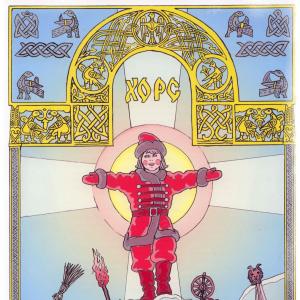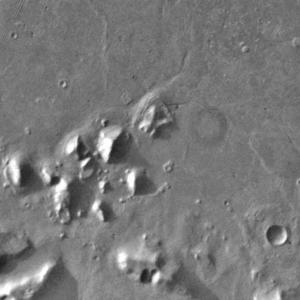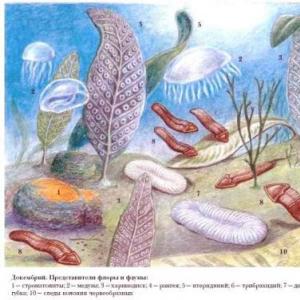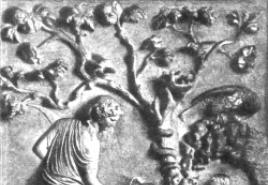Indian mythology and its reflection in art. Indian mythology
The mirror of Indian myths reflects not only the striking contrasts of nature, but also its complex ethnic history. The original dark-skinned population met at the end of the 2nd millennium with white-skinned newcomers, the Aryans. In the stories of Indians about their gods, there are many strange, incomprehensible, outlandish things. This is due not only to the uniqueness of the natural environment in which the Aryans found themselves, but also to the centuries-old interaction of their religious and mythological ideas with the myths and beliefs of the local population.
Understanding Indian myths is complicated by the fact that we are dealing not with one, but with several mythologies that maintain connections and continuity and at the same time differ from each other. If we ignore some options, this is Vedic, Hindu, Buddhist mythology. Each of them has its own sacred texts.
The main source for the study of Vedic mythology and, in general, the most ancient monument of Indian literature is the Vedas. These are collections (samhitas) of spells, prayers and hymns to spirits and gods, performed during sacrifices and other religious rites, which began to take shape at the turn of the 2nd-1st millennium BC, when the Aryans, having left their original habitat in Punjab, moved to the Ganges valley. The first Aryan states appeared here, which required the creation of a state cult and priesthood. In priestly schools from the 10th to the 6th centuries. BC e., apparently, collections were compiled and formalized, which continued to be stored in memory for a long time.
The most archaic material was included in the collection “Rigveda”. The name itself means "Veda of Hymns". Hymns, naturally, cannot contain a coherent story about spirits and gods, but the nameless singers who created these hymns, as well as the singers who performed them, had such ideas. Based on the hymns of the Rig Veda and other similar collections of the Vedas, modern scientists recreate what we call myths.
The Vedas reveal a vast and colorful world of gods of various levels, higher and lower. There were numerous gods who personified the forces of nature on which man was entirely dependent.
The Lord of the waters, heavenly, earthly, underground, as well as their personification in the Vedas, was the god Varuna. Since water was thought of as the fundamental principle of life, he was called the Almighty and Creator, who created the world and holds it, filling the airspace, illuminating the sky and earth, giving movement to the sun.
Initially, Varuna was the main god of the Indo-Aryans, but then he was pushed aside by the warrior god and thunderstormer Indra, who takes over many of Varuna’s original functions and becomes the god who ensures the existence of the cosmos. After Varuna was pushed aside by Indra, he retained the role of guardian of cosmic order and human laws, and arbiter of justice.
There was a group of gods representing various manifestations of the sun. The main one is Surya. The sun is his eye, but he himself is the eye of the gods. This is a benevolent god, dispelling darkness, giving wealth and health. Pushan (“Blooming”, “Puffy”) is the solar god, embodying the fruitful power of the sun, and, accordingly, he moves across the sky on a chariot drawn by goats, fertile animals, while Surya’s chariot is drawn not by animals, but by rays. Savitar is also a solar god. He awakens the universe from sleep, gives it light, blesses it. Vishnu, one of the main cosmic gods embodying the principle of trinity, familiar to us from Avestan mythology, was also considered a solar deity. Vishnu takes three steps, covering the entire Universe with them, while the third step, which falls on the highest sky, is hidden from the sight of mortals.
Like other Indo-European peoples, the Indians revered the dawn in the form of a young maiden riding into the night sky on a sparkling chariot. The Indian Aurora bore the name Ushas and was related to the sky and Surya. While remaining a virgin, she was at the same time considered the mother of the heavenly twins Ashwins, similar to the Greek Dioscuri.
In addition to Indra, the Maruts, the deities of storms, wind, thunder and lightning, were in charge of atmospheric phenomena. Swift young men, armed with golden axes, spears, arrows, knives. They rush across the sky, bringing wind and thunderstorms; a storm, breaking rocks and trees, giving life and sowing death.
All gods, as a community, are opposed by groups of spirits and demons, apparently the same gods, but occupying a lower position - asuras, dasas, rakshasas, gandharvas, pishachis, etc. Collectivism of gods and spirits reflects the original community of property and cohesion of clan groups - the main cells of primitive society during the creation of myths about spirits. It is noteworthy that female deities among the Aryan cattle breeders occupy a secondary position. This characterizes the dominance of patriarchal relations.
The Vedas contain the names of more than three dozen gods. But one of the Vedas talks about 3,399 gods. The plurality of gods is a feature inherent in mythologies from other Indo-European peoples: let us remember the thousand gods of the Hittites. These thousands of gods could be the patrons of individual clans and tribes or deities of individual stages of human life, religious objects (sacrificial table, sacrificial straw), weapons, elements of nature (rivers, mountains, large trees, medicinal herbs);
The images of these gods are not as definite as in Greek mythology, where they have a human appearance. It seems that the world of the gods has just emerged from chaos. It is still fluid and undefined. They are sometimes people, sometimes animals, sometimes abstract concepts such as Vach (“Speech”), Aditi (“Unconnectedness”), Talas (“Cosmic Fat”). Sometimes, like the half-baby Aruna, they have a formed head and body, but they lack legs. The god Savitar has only golden hands, raised in blessing, not connected to his body and all the more clearly expressing his essence. The creator god Tvashtar has one hand, but with an ax, an instrument of creation.
With some joy of recognition, I meet among the Indian gods Mithra, Apam-Napata, the king of the golden age Iima with a slightly modified name Yama, the poured homu (in the form of soma). And this does not surprise us, for we know that the creators of both mythologies were one people - the Aryans. But we cannot be left by the fact that among the Vedic pantheon we find exact correspondences with the gods of the peoples of ancient and new pagan Europe: Dyaus-Pitar - Jupiter, Paryadzhoia (god of thunderstorms) - Lithuanian Perkunas, Slavic Perun, Ushas - Latvian Usinsh, Maruts - Latin Mars and finally, deva (god) - Latin "deus". And we are already beginning to listen to the sound of the names of Indian gods and sacred concepts that were previously alien to us: Agni, of course, fire. Vayu, Vata (vey, wind). Vedas - to know, sorcerer, witch. Yes, the “Vedas” are knowledge, in the sense of “knowledge is power,” but a specific power, addressed to the world of supernatural forces, mysterious to ancient people, helping to appease them, and sometimes force them to fulfill the will that is alien to them.
Over the centuries, the languages of the peoples of India and their ideas about the gods have changed. The Vedas, which retained the meaning of sacred texts, became obscure. Commentaries on the Vedas were required, and they were created within the same schools in which the Vedic canon was formed. These were teachings to the priests - “Brahmins”. They scrupulously explain the details of sacrifices, and also give interpretations of myths that are speculative in nature. But, at the same time, the text of “Brahmins” contains myths, legends and tales, both parallel to the Vedic ones and unknown to them, sometimes more ancient. The latter include the legend of the flood, close to the myths of Mesopotamia, and the legend of the love of Pururavasa and Urvashi. The second group of texts is the “Aranyaki” (“Forest Books”), associated with the symbolism of the sacrificial act.
The philosophical orientation of the "Brahmins" is continued by the third group of Vedic literature - the "Upanishads". These are treatises written partly in verse and partly in prose. Their chain was teaching the correct execution of ancient rites and comprehending their hidden meaning. So, if in the early myths the creation of various parts of the world is drawn as a result of cutting into parts of a person who is sacrificed, then in one of the Upanishads this same person is interpreted as the World Mind, the original thought and, moreover, the conscious activity of gods and people as its manifestation. Commenting on the Vedas, the authors of the Upanishads treat them with a certain amount of irony, as a monument of the savage era, which does not give true knowledge. Thus, it is said: “Those who follow the Vedas, considering themselves to be knowledgeable and learned people, actually wander, like blind men led by a blind guide, and cannot reach the goal.” Thus, the "Upanishads" oppose the "Vedas" as knowledge against ignorance, as thought against the illusory world of religion. The Upanishads developed teachings on the unity of animate and inanimate nature, on the cycle of births, which became the basis of Indian philosophy.
Legends and heroic tales, handed down from generation to generation, became the basis of Indian heroic poems, similar to the epic of Gilgamesh familiar to us. One of them - "Mahabharata" was considered by the Indians themselves as a continuation of the "Vedas", was considered the fifth "Veda", intended, unlike the first four, for the common people. "Mahabharata" is dedicated to the struggle of two clans, Pandavas and Kauravas, for dominance in the kingdom located in the upper reaches of the Ganges, with the capital Hastinapur. The epic poet's sympathy is on the side of the Pandavas, the sons of the gods Indra, Vayu, and Ashvins, who are the legal heirs of the famous Bharata family. Kauravas are envious and insidious, ready for any crime. Despite the small number of Pandavas, they manage to avoid the traps set by their opponents and find a way out of a seemingly hopeless situation. It comes to a grandiose battle on the Kuru field, where the Pandavas and their supporters defeat the Kaurava army, but the Pandavas’ supporters also die. Only five Pandavas remain alive. Together with their common wife, they go to the Himalayas to become hermits. The adventures of the heroes are diluted with inserted episodes and digressions, which, in fact, constitute the essence of the poem, grandiose in volume and scale of action, which is called the “encyclopedia of ancient Indian life.”
"Mahabharata" reflects some historical events, inter-tribal wars of the heroic age (end of the first millennium BC). But it is impossible to say whether the heroes named in the poem were historical figures. This is a feature of the epic poems of all peoples. Reality is transformed by fantasy beyond recognition. The images of the Mahabharata express ideas about the virtues of the heroes of the primitive communal system, but at the same time, their activities characterize the orders that existed in developed states. This confusion of eras is not surprising. Later passages were layered on the original ancient skeleton, overgrown with “meat” alien to it. This “meat” was legends that existed not in the military environment in which the poem originated, but in the priestly, Brahmin environment. With the epics glorifying the kshatriyas, approximately the same thing happened as with the victory songs of Mariam and Deborah, included in the Old Testament canon. They began to glorify the gods and priests. And the writing of the poem itself was apparently carried out by the priests.
Unlike the Mahabharata, another major poem of the ancient Indians, the Ramayana, produces a more holistic impression. Its final edition is believed to have been carried out by a narrator close to court circles, who tried to bring the poem closer to the literary canons of his time (III - IV centuries). Lyrical descriptions of nature and some psychological motivation for the characters’ behavior appear. Despite the archaic nature of the plot basis, which goes back to even more ancient times than the plot of the Mahabharata, the presentation itself is closer to a fairy tale than to a strict myth.
The mythology of India is a complex phenomenon due to the fact that the Indian subcontinent is home to a variety of peoples of very dissimilar origins with vastly different cultural and mythological backgrounds.
One can distinguish between the ancient Vedic mythology that existed before our era, and the modern mythology and philosophy of Hinduism, the living religion of modern India. It is also worth mentioning the Buddhist and Jain mytho-religious systems, which are also relevant for India.
Vedic mythology
Vedic mythology developed at the end of the 2nd millennium BC in the northwestern part of India, inhabited by Aryan tribes who came from Iran. Due to kinship with Iran, the mythology and language of the northern part of India was similar to Iranian. It is customary even to talk about a certain period of Indo-Iranian relations, about the Indo-Iranian language and culture.
Indian Mythology: The dancing god Shiva, the origins of Vedic mythology are rooted in the common Indo-European mythology of the 3rd millennium BC. Because of its archaic nature, Vedic mythology and language serve as an excellent source for understanding the antiquity of all Indo-Europeans. One can see the deep connection of words such as “veda” with the Russian verb “vedat” and the words “witch”, “vedenie”, etc. derived from it.
Gods of ancient India
The Vedic pantheon consisted of 33 deities, some of which lived on Earth, some in Heaven, and some were universal.
The earthly gods were Prithivi, Agni, Brihaspati, Soma, Saraswati. The “mixed” gods included Indra, Trita Aptya, Apam Napat, Matarisvan. The heavenly gods were Dyaus, Varuna, Mitra, Vishnu, Ushas and Ashvins.
Indian mythology: god Vishnu These gods played an important role in the life of the ancient inhabitants of India. Life and religious foundations were supported by Varuna and Mitra, Indra and his assistants, the Maruts, were in charge of the war, and the Ashwins were responsible for fertility and harvest.
Later, Brahma, Vishnu and Shiva stood out among the main gods - this was already a significant step towards later Hinduism, which absorbed both Vedic mythology and the mythological ideas of other inhabitants of Hindustan.
The ancient Indian gods were divided into two groups: devas and asuras, who fought among themselves. A legend has been preserved that during the battle of these gods, drops of their blood fell to the ground, solidified and turned into precious stones.
Vedic myths
Indian mythology: Rama and Lakshmana go in search of Sita One of the main myths of Vedic mythology told how the warlike god Indra fought with his monstrous opponent - the demon Vritra, who personified chaos and the unruly forces of nature. Vritra blocked the world's waters and stole cattle from people, and Indra freed them.
Mahabharata
One of the largest sources on Indian mythology is the majestic epic Mahabharata. It represents one of the most striking cultural heritage of humanity. Mahabharata consists of many legends and traditions. The Ramayana is part of the Mahabharata.
Ramayana
Indian mythology: Rama, an avatar of the god Vishnu Another famous epic of India is the Ramayana. It tells how the demon king Ravana seized power over the world and forced the gods to serve him.
To get rid of his tyranny, the god Vishnu decided to be born on earth in the guise of a mortal, whose name was Rama. The birth of a god in the guise of a mortal in Indian mythology is called an avatar, that is, incarnation.
The struggle between Rama and Ravana began after Ravana kidnapped the beautiful Sita, Rama's wife. Together with his faithful friend Lakshmana, Rama went to rescue his wife, and with the help of the hawk king Jatayu and the ape king Sugriva, he defeated him in fierce battles and returned his wife.
edited news Desmond Miles - 8-04-2011, 23:55
The main monuments that reflected the mythological ideas of the Egyptians are various religious texts: hymns and prayers to the gods, records of funeral rites on the walls of tombs. The most significant of them are the “Pyramid Texts” - the oldest texts of the royal funeral rituals.
Carved on the walls of the interior of the pyramids of the pharaohs of the V and VI dynasties of the Old Kingdom (XXVI - XXIII centuries BC); “Texts of sarcophagi”, preserved on sarcophagi from the Middle Kingdom era (XXI - XVIII centuries BC...
It is impossible to imagine a prouder and more grateful image than that of the Aryan king of India, standing on his war chariot and giving orders to a whole army of elephants, horsemen and foot soldiers. One Vedic priest initiates his king in front of the assembled crowd with these words: “I have brought you into our midst.
All the people want you. The sky is steadfast, the earth is steadfast and these mountains are steadfast."
In one of the later legislations, in the Manava Dharma Shastra, one can read:
"These lords...
Justice reigned during the time of the noble sons of Pandu, the kings of the solar cycle, who listened to the voices of the sages. Winners, they treated the vanquished as equals. But since the sons of the sun were exterminated or removed from their thrones, and their rare descendants hid among the hermits, injustice, ambition and hatred took over.
Changeable and deceitful, like the night luminary, which they took as their symbol, the kings of the lunar cycle fought among themselves mercilessly. One of them...
Having rested, she went deeper into the forest under the cool arches formed from majestic trunks, the branches of which sank into the soil and, rising again, spread out their green tents in all directions.
She walked for a long time, protected from the sun, as if in a dark and cool pagoda with no end in sight.
The buzzing of bees, the cries of loving peacocks, the singing of thousands of birds, drew her further and further, and the trees became more and more huge, the forest became darker, and the tree branches became more and more closely intertwined in...
All religious beliefs have their origin in India or are influenced by Indian holy scriptures. Indian saints did not seek identification with religious forms and words. They asked: “What science will help us find God? Who is He, by knowing whom I will know all things?”
Indian civilization is much older than Egyptian civilization. First of all, material life arose, then intellectual life and then the era of spiritual exploration. Every nation must go through these three stages...
Ancient Egypt is a powerful civilization of antiquity; it still attracts researchers with its mystery and grandeur. The ancient Egyptians had a special attitude towards religion, which left a huge imprint on their culture and way of life.
The role of religion in ancient Egypt
The daily life of the Egyptians was closely intertwined with beliefs and religious traditions. The ancient Egyptians believed that cults had the ability to directly influence their destiny. In that era, even small details were given...
Vedic mythology - a set of mythological ideas of the Vedic Aryans; Vedic mythology is usually understood as the mythological ideas of the Aryans during the period of creation of the Vedas, and sometimes also the period of creation of Brahmanas, prosaic commentaries on the Vedas, and Upanishads, secret teachings of a philosophical and religious nature, genetically related to the Vedas, but reflecting, in fact, a different cultural tradition .
Chronologically, Vedic mythology belongs to the era between the middle of the 2nd and the middle. 1st thousand to...
The tribes of the ancient Rus about 40 thousand years ago, according to legend (With special permission, the author is the first in the world to publish a special secret history of the great Russian people, passed down for thousands of years only according to the secret oral Vedic tradition.), came from Arabia (the upper reaches of the Tigris River ) to the north of the Balkans.
"Rus", in ancient Arabian, means "leopard." Then the Rus moved north and settled virgin forests rich in game. Some tribes went even further north, taming
Besides the horses...
More than 25 centuries ago, in one of the small states of India, a son, Siddhartha Gautama, was born to King Shuddhodana and his wife Maya.
The prince lived in luxury, without worries or sorrow. But having learned that illness, old age and death exist in the world, the prince decided to save people from suffering and went in search of...
India, a peninsula not inferior in territory to all the countries of the Near East combined, is distinguished by its exceptional natural diversity. The highest snowy mountains in the world, the kingdom of the eternal Himavata (“Winter”). The mighty rivers Indus and Ganges, brothers of the Tigris, Euphrates and Nile, played a similar role in the creation of agricultural cultures. Lifeless deserts, similar to the deserts of Arabia and Libya (Africa). Tropical forests with an incredible abundance of wild animals, birds, snakes, insects. And the same immense variety of myths! Deafening sounds! Bright colors! An incredible wealth of imagination!
The mirror of Indian myths reflects not only the striking contrasts of nature, but also its complex ethnic history. The original dark-skinned population met at the end of the 2nd millennium with white-skinned newcomers, the Aryans, the same ones whose mythology we have just become acquainted with. In the stories of Indians about their gods there are many mythological features already known to us, but there are no less strange, incomprehensible, outlandish things in them. This is due not only to the uniqueness of the natural environment in which the Aryans found themselves, but also to the centuries-old interaction of their religious and mythological ideas with the myths and beliefs of the local population.
Understanding Indian myths is complicated by the fact that we are dealing not with one, but with several mythologies that maintain connections and continuity and at the same time differ from each other. If we ignore some options, this is Vedic, Hindu, Buddhist mythology. Each of them has its own sacred texts.
The main source for the study of Vedic mythology and, in general, the most ancient monument of Indian literature is the Vedas. These are collections (samhitas) of spells, prayers and hymns to spirits and gods, performed during sacrifices and other religious rites, which began to take shape at the turn of the 2nd-1st millennium BC, when the Aryans, having left their original habitat in Punjab, moved to the Ganges valley. The first Aryan states appeared here, which required the creation of a state cult and priesthood. In priestly schools from the 10th to the 6th centuries. BC e., apparently, collections were compiled and formalized, which continued to be stored in memory for a long time.
The most archaic material was included in the collection “Rigveda”. The name itself means "Veda of Hymns". Hymns, naturally, cannot contain a coherent story about spirits and gods, but the nameless singers who created these hymns, as well as the singers who performed them, had such ideas. Based on the hymns of the Rigveda and other similar collections of the Vedas, modern scientists recreate what we call myths.
The Vedas reveal a vast and colorful world of gods of various levels, higher and lower. There were numerous gods who personified the forces of nature on which man was entirely dependent.
The Lord of the waters, heavenly, earthly, underground, as well as their personification in the Vedas, was the god Varuna. Since water was thought of as the fundamental principle of life, he was called the almighty and creator, who created the world and holds it, filling the air space, illuminating the sky and earth, giving movement to the sun.
Initially, Varuna was the main god of the Indo-Aryans, but then he was pushed aside by the warrior god and thunderstormer Indra, who takes over many of Varuna’s original functions and becomes the god who ensures the existence of the cosmos. After Varuna was pushed aside by Indra, he retained the role of guardian of cosmic order and human laws, and arbiter of justice.
There was a group of gods representing various manifestations of the sun. The main one is Surya. The sun is his eye, but he himself is the eye of the gods. This is a benevolent god, dispelling darkness, giving wealth and health. Pushan (“Blooming”, “Puffy”) is the solar god, embodying the fruitful power of the sun, and, accordingly, he moves across the sky on a chariot drawn by goats, fertile animals, while Surya’s chariot is drawn not by animals, but by rays. Savitar is also a solar god. He awakens the universe from sleep, gives it light, blesses it. Vishnu, one of the main cosmic gods embodying the principle of trinity, familiar to us from Avestan mythology, was also considered a solar deity. Vishnu takes three steps, covering the entire universe with them, while the third step, which falls on the highest sky, is hidden from the sight of mortals.
Like other Indo-European peoples, the Indians revered the dawn in the form of a young maiden riding into the night sky on a sparkling chariot. The Indian Aurora bore the name Ushas and was related to the sky and Surya. While remaining a virgin, she was at the same time considered the mother of the heavenly twins Ashwins, similar to the Greek Dioscuri.
In addition to Indra, the Maruts, the deities of storms, wind, thunder and lightning, and swift young men armed with golden axes, spears, arrows, and knives, were in charge of atmospheric phenomena. They rush across the sky, bringing wind and thunderstorms; a storm, breaking rocks and trees, giving life and sowing death.
All gods as a community are opposed by groups of spirits and demons, apparently the same gods, but occupying a lower position - asuras, dasas, rakshasas, gandharvas, pishachis, etc. Collectivism of gods and spirits reflects the original community of property and cohesion of clan groups - the main unit of the primitive societies of the time when myths about spirits were created. It is noteworthy that female deities among the Aryan cattle breeders occupy a secondary position. This characterizes the dominance of patriarchal relations.
The Vedas contain the names of more than three dozen bugs. But one of the Vedas talks about 3,399 gods. The plurality of gods is a feature inherent in the mythologies of other Indo-European peoples: let us remember the thousand gods of the Hittites. These thousands of gods could be patrons of individual clans and tribes or deities of individual stages of human life, religious objects (sacrificial table, sacrificial straw), weapons, elements of nature (rivers, mountains, large trees, medicinal herbs);
The images of these gods are not as definite as in Greek mythology, where they have a human appearance. It seems that the world of the gods has just emerged from chaos. It is still fluid and uncertain. They are either people or animals, or abstract concepts such as Vach (“Speech”), Aditi (“Disconnectedness”), Talas (“Cosmic Fat”). Sometimes, like the half-baby Aruna, they have a formed head and body, but they lack legs. The god Savitar has only golden hands, raised in blessing, not connected to his body and all the more clearly expressing his essence. The creator god Tvashtar has one hand, but with an ax, an instrument of creation.
With some joy of recognition, we meet among the Indian gods our recent characters: Mithra, Apam-Napata, the king of the golden age Iima with a slightly modified name Yama, the poured homa (in the form of soma). And this does not surprise us, for we know that the creators of both mythologies were one people - the Aryans. But we cannot be left indifferent by the fact that among the Vedic pantheon we find exact correspondences with the gods of the peoples of ancient and new pagan Europe: Dyaus-Pitar - Jupiter, Paryadzhoia (god of thunderstorms) - Lithuanian Perkunas, Slavic Perun, Ushas - Latvian Usinsh, Maruts - Latin Mars and finally deva (god) - Latin "deus". And we are already beginning to listen to the sound of the names of Indian gods and sacred concepts that were previously alien to us: Agni, of course, fire). Vayu, Vata (vey, wind). Vedas - to know, sorcerer, witch. Yes, the “Vedas” are knowledge, in the sense of “knowledge is power,” but a specific power, addressed to the world of supernatural forces, mysterious to ancient people, helping to appease them, and sometimes force them to fulfill the will that is alien to them.
Over the centuries, the languages of the peoples of India and their ideas about the gods have changed. The Vedas, which retained the meaning of sacred texts, became obscure. Commentaries on the Vedas were required, and they were created within the same schools in which the Vedic canon was formed. These were teachings to the priests - “Brahmins”. They scrupulously explain the details of sacrifices, and also give interpretations of myths that are speculative in nature. But at the same time, the text of “Brahmins” is interspersed with myths, legends and renderings, both parallel to the Vedic ones and unknown to them, sometimes more ancient. The latter include the legend of the flood, close to the myths of Mesopotamia, and the legend of the love of Pururavasa and Urvashi. The second group of texts is the “Aranyaki” (“Forest Books”), associated with the symbolism of the sacrificial act.
The philosophical orientation of the "Brahmins" is continued by the third group of Vedic literature - the "Upanishads". These are treatises written partly in verse and partly in prose. Their chain was teaching the correct execution of ancient rites and comprehending their hidden meaning. So, if in the early myths the creation of various parts of the world is drawn as a result of cutting into parts of a person who is sacrificed, then in one of the Upanishads this same person is interpreted as the World Mind, the original thought and, moreover, the conscious activity of gods and people as its manifestation. Commenting on the Vedas, the authors of the Upanishads treat them with a certain amount of irony, as a monument of the savage era, which does not give true knowledge. Thus, it is said: “Those who follow the Vedas, considering themselves knowledgeable and learned people, actually wander, like blind men led by a blind guide, and cannot achieve their goal.” Thus, the “Upanishads” are opposed to the “Vedas” as knowledge - ignorance, as thought - to the illusory world of religion. The Upanishads developed teachings on the unity of animate and inanimate nature, on the cycle of births, which became the basis of Indian philosophy.
Legends and heroic tales, handed down from generation to generation, became the basis of Indian heroic poems, similar to the epic of Gilgamesh familiar to us. One of them, the Mahabharata, was considered by the Indians themselves as a continuation of the Vedas and was considered the fifth Veda, intended, unlike the first four, for the common people. "Mahabharata" is dedicated to the struggle of two clans, Pandavas and Kauravas, for dominance in the kingdom located in the upper reaches of the Ganges, with the capital Hastinapur. The epic poet's sympathy is on the side of the Pandavas, the sons of the gods Indra, Vayu, and Ashvins, who are the legal heirs of the famous Bharata family. Kauravas are envious and insidious, ready for any crime. Despite the small number of Pandavas, they manage to avoid the traps set by their opponents and find a way out of a seemingly hopeless situation. It comes to a grandiose battle on the Kuru field, where the Pandavas and their supporters defeat the Kaurava army, but the Pandavas’ supporters also die. Only five Pandavas remain alive. Together with their common wife, they go to the Himalayas to become hermits. The adventures of the heroes are diluted with inserted episodes and digressions, which, in fact, constitute the essence of the poem, grandiose in volume and scale of action, which is called the “encyclopedia of ancient Indian life.”
"Mahabharata" reflects some historical events, inter-tribal wars of the heroic age (end of the millennium BC). But it is impossible to say whether the heroes named in the poem were historical figures. This is a feature of the epic poems of all peoples. Reality is transformed by fantasy beyond recognition. The images of the Mahabharata express ideas about the virtues of the heroes of the primitive communal system, but at the same time, their activities characterize the orders that existed in developed states. This confusion of eras is not surprising. Later passages were layered on the original ancient skeleton, overgrown with “meat” alien to it. This “meat” was legends that existed not in the military environment in which the poem originated, but in the priestly, Brahmin environment. With the epics glorifying the kshatriyas, approximately the same thing happened as with the victory songs of Mariam and Deborah, included in the Old Testament canon. They began to glorify the gods and priests. And the writing of the poem itself was apparently carried out by the priests.
Unlike the Mahabharata, another major poem of the ancient Indians, the Ramayana, produces a more holistic impression. Its final edition is believed to have been carried out by a narrator close to court circles, who tried to bring the poem closer to the literary canons of his time (III - IV centuries). Lyrical descriptions of nature and some psychological motivation for the characters’ behavior appear. Despite the archaic nature of the plot basis, which goes back to even more ancient times than the plot of the Mahabharata, the presentation itself is closer to a fairy tale than to a strict myth.
Along with heroes and demonic creatures, gods act in the Mahabharata and Ramayana. Three gods come first: Brahma - the creator god, Vishnu - the guardian god, Shiva - the destroyer god.
Brahma is not mentioned in the Vedas, but some of his functions are performed by the god Prajapati, the creator of all things. In the Mahabharata, Brahma has the epithets Creator, Establisher, Distributor, and Mentor of the world. The name Prajapati also becomes his epithet. In iconography, he was depicted as a bearded man with four bodies, four faces of a reddish hue and eight hands, in which there are four Vedas, a rod, a jar of sacred Ganges water, a sacrificial spoon, sometimes also a pearl necklace, a bow and a lotus flower. Its habitat is the greatest mountains of Meru. He usually moves on a swan. Like some other gods, Brahma has the gift of reincarnation. Taking the form of a fish, he saves Manu, the progenitor of mankind, from the flood.
Vishnu “is already known by the Vedas,” where he performs the same function as the guardian of the universe, which he measures by his three steps. But in the Vedas he is a second-rate deity, while in the Mahabharata he is the greatest god, relegating Indra to the background. This is expressed in one of his epithets - Atindra "Greater than Indra". Vishnu was conceived as living in a special part of the sky, washed by the celestial Ganges. He either stands fully armed or reclines on the coiled snake Sheshu. In his four hands is a sparkling disk with the property of returning, a conch shell, a mace, a lotus or a bow. Vishnu has many forms. He moves on the bird Garuda.
Shiva is thought of as the owner of world energy, which sets everything in motion, destroys and revives. In the Vedas, his predecessor is Rudra, who in the epic turns into an epithet of Shiva. Shiva was depicted with four or five faces. He is a great warrior, armed with a sword, bow, shield, a formidable opponent of demons, and at the same time, a hermit who secluded himself in Himayayah and spends centuries there alone or with his wife, who has many forms and names.
Ancient Indian literature in the Vedas, Mahabharata and Ramayana contains not only legends and religious instructions. It simultaneously introduces the life and spiritual development of the peoples of India.
Mythology of India is a complex phenomenon due to the fact that the Indian subcontinent is home to a variety of peoples of very dissimilar origins with completely different cultural and mythological origins.
One can distinguish between the ancient Vedic mythology that existed before our era, and the modern mythology and philosophy of Hinduism, the living religion of modern India. It is also worth mentioning the Buddhist and Jain mytho-religious systems, which are also relevant for India.
Vedic mythology
Vedic mythology developed at the end of the 2nd millennium BC in the northwestern part of India, inhabited by Aryan tribes who came from Iran. Due to kinship with Iran, the mythology and language of the northern part of India was similar to Iranian. It is customary even to talk about a certain period of Indo-Iranian relations, about the Indo-Iranian language and culture.
 The origins of Vedic mythology are rooted in the general Indo-European mythology of the 3rd millennium BC. Because of its archaic nature, Vedic mythology and language serve as an excellent source for understanding the antiquity of all Indo-Europeans. One can see the deep connection of words such as “veda” with the Russian verb “vedat” and the words “witch”, “vedenie”, etc. derived from it.
The origins of Vedic mythology are rooted in the general Indo-European mythology of the 3rd millennium BC. Because of its archaic nature, Vedic mythology and language serve as an excellent source for understanding the antiquity of all Indo-Europeans. One can see the deep connection of words such as “veda” with the Russian verb “vedat” and the words “witch”, “vedenie”, etc. derived from it.
Gods of ancient India
The Vedic pantheon consisted of 33 deities, some of which lived on Earth, some in Heaven, and some were universal.
The earthly gods were Prithivi, Agni, Brihaspati, Soma, Saraswati. The “mixed” gods included Indra, Trita Aptya, Apam Napat, Matarisvan. The heavenly gods were Dyaus, Varuna, Mitra, Vishnu, Ushas and Ashvins.
 These gods played an important role in the life of the ancient inhabitants of India. Life and religious foundations were supported by Varuna and Mitra, Indra and his assistants, the Maruts, were in charge of the war, and the Ashwins were responsible for fertility and harvest.
These gods played an important role in the life of the ancient inhabitants of India. Life and religious foundations were supported by Varuna and Mitra, Indra and his assistants, the Maruts, were in charge of the war, and the Ashwins were responsible for fertility and harvest.
Later, Brahma, Vishnu and Shiva stood out among the main gods - this was already a significant step towards later Hinduism, which absorbed both Vedic mythology and the mythological ideas of other inhabitants of Hindustan.
The ancient Indian gods were divided into two groups: devas and asuras, who fought among themselves. A legend has been preserved that during the battle of these gods, drops of their blood fell to the ground, solidified and turned into precious stones.
Vedic myths
 One of the main myths of Vedic mythology told how the warlike god Indra fought with his monstrous opponent - the demon Vritra, who personified chaos and the unruly forces of nature. Vritra blocked the world's waters and stole cattle from people, and Indra freed them.
One of the main myths of Vedic mythology told how the warlike god Indra fought with his monstrous opponent - the demon Vritra, who personified chaos and the unruly forces of nature. Vritra blocked the world's waters and stole cattle from people, and Indra freed them.
Mahabharata
One of the largest sources on Indian mythology is the majestic epic Mahabharata. It represents one of the most striking cultural heritage of humanity. Mahabharata consists of many legends and traditions. The Ramayana is part of the Mahabharata.
Ramayana
 Another famous epic of India is the Ramayana. It tells how the demon king Ravana seized power over the world and forced the gods to serve him.
Another famous epic of India is the Ramayana. It tells how the demon king Ravana seized power over the world and forced the gods to serve him.
To get rid of his tyranny, the god Vishnu decided to be born on earth in the guise of a mortal, whose name was Rama. The birth of a god in the guise of a mortal in Indian mythology is called an avatar, that is, incarnation.
The struggle between Rama and Ravana began after Ravana kidnapped the beautiful Sita, Rama's wife. Together with his faithful friend Lakshmana, Rama went to rescue his wife, and with the help of the hawk king Jatayu and the ape king Sugriva, he defeated him in fierce battles and returned his wife.
 In the illustrations:
In the illustrations:
1. King Rama, his friend Lakshmana, wife Sita and the monkey king Sugriva
2. Dancing god Shiva
3. God Vishnu
4. Rama and Lakshmana with their companions go in search of Sita
5. Rama, the seventh avatar of the god Vishnu
6. A modern production of the Ramayana during an international festival dedicated to the Indian epic







